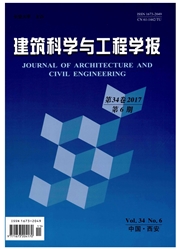

 中文摘要:
中文摘要:
深梁是受力较为复杂的构件,特别是开孔深梁的传力机制还有待进一步研究。采用优化的方法构造深梁的压杆.拉杆模型是近年来研究的新思路,该文选择寻优能力较强的拓扑优化方法——遗传演化结构优化算法,建立能反映开孔深梁真实传力机理的压杆.拉杆模型,以一个对称开洞的简支梁为例,计算了孔洞的大小不同、位置不同时的压杆.拉杆模型,并与经典的优化设计准则Miche11准则比较来验证压杆.拉杆模型的合理性。另外,以一个偏洞口深梁为例,讨论不同荷载作用下开孔深梁的压杆.拉杆模型,该文的研究证明遗传演化算法可方便地构造开孔深梁的压杆.拉杆模型,其所建立的模型能为工程设计提供有益的参考。
 英文摘要:
英文摘要:
The mechanisms of deep beams are complex, especially the deep beams with openings. Some optimization methods are newly introduced to construct the strut-and-tie models of deep beams by other researchers. In this paper a robust topology optimization method named genetic evolutionary structural optimization (GESO) is used to construct the strut-and-tie models which reflect the real transfer mechanisms of deep beams with openings. The first example is a simply supported deep beam with two symmetrical openings. The beams with different hole sizes and different hole positions are calculated and the results' rationalities are demonstrated by the classic optimal Michell criterion. The other example is a deep beam with unsymmetrical opening under different loads. The researches in this paper prove the effectiveness of the GESO and the models acquired in the paper will provide useful references for the engineers.
 同期刊论文项目
同期刊论文项目
 同项目期刊论文
同项目期刊论文
 Discussion of “Effect of near-fault vertical ground motions on seismic response of highway overcross
Discussion of “Effect of near-fault vertical ground motions on seismic response of highway overcross Application of a PVDF-based stress gauge in determining dynamic stress–strain curves of concrete und
Application of a PVDF-based stress gauge in determining dynamic stress–strain curves of concrete und 期刊信息
期刊信息
